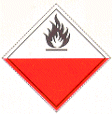| Wool | [German version] |
Table of contents |
|
| General: | ||
| Product information | ||
| Packaging | ||
| Transport | ||
| Container transport | ||
| Cargo securing | ||
Product information
Product name
| German | Wolle, Schweißwolle, Rohwolle |
| English | Wool, greasy wool |
| French | Laine en suint |
| Spanish | Lana sucio |
| CN/HS number * | 51 ff. |
(* EU Combined Nomenclature/Harmonized System)
Product description
Wool (sheep’s wool), a protein fiber, is the highest value textile fiber. The value of raw wool, or more precisely greasy wool, is assessed on the basis of its content of 5 main constituents, e.g. Merino wool contains:
| 49% fibers | |
| 19% wool grease (lanolin) | |
| 6% suint | |
| 16% dirt (sand, dust, excrement, plant particles) | |
| 10% water |
The main factor in determining the value of a fleece is its pure wool content. Depending on cleanness, a distinction is drawn between the following types:
| greasy wool, unscoured wool | |
| scoured wool | |
| snow white wool |
Grease or unwashed wool or wool in the suint is the unscoured raw wool with a fiber content of only around 50%, in contrast to scoured wool.
Wool fibers consist of a cellular structure of keratin covered with scales. A schematic cross-section through a wool fiber reveals the following structure:
The scale layer consisting of keratinized protein cells protects the inside of the fiber and is one of the factors responsible for wool’s felting property and thus for its good warmth retention properties. The fine, resilient intermediate membrane (basal membrane) allows both dyes and moisture to penetrate into the wool fiber. The cortical cell layer (cortex) forms the body of the fiber. It influences important characteristics such as strength, stretch, elasticity and crimp. The medulla is responsible for feeding the wool fiber and does not contribute in any way to its strength.
Wool is classified by:
| breed and wool quality | |
| recovery method | |
| body part and fineness | |
| cleanness | |
| hair type | |
| gender and age | |
| Origin | |
| production purpose |
Breeds are divided into three groups:
| Breed group | Wool formation | Wool qualities | Production suitability |
|---|---|---|---|
| 1. Highland sheep | The sheep live at high altitudes, their hair developing as a protection against the cold. | Very fine, highly crimped, soft, short wool | Suitable for carded yarn production |
| 2. Lowland sheep | The sheep live at low altitudes, their hair developing as a protection against rain. | Strong, relatively uncrimped, lustrous, long wool | Suitable for worsted yarn production |
| 3. Crossbred sheep | Crosses between highland sheep (ewes) and lowland sheep (rams) | Medium fine, moderately crimped, medium length wool | Suitable for carded and worsted yarn production |
Quality / Duration of storage
Spinnable animal hair obtained as a fleece by shearing and distinguished by certain properties (e.g. fineness, crimp, stretch, length, felting property); a distinction is drawn between shear wool (highest quality), pelt or slipe wool (from skins of slaughtered healthy animals, somewhat lower quality) and fallen wool (poorest quality).
Wools with a well developed medulla are coarse, wools lacking a medulla being in great demand. Medium fine wools have only residual „islands“ of medulla while the finest wool fibers have no medulla at all.
Greasy wool is traded on the basis of its scoured weight, as 30 – 50% of its raw weight may be accounted for by suint, wool grease (lanolin) and dirt.
Intended use
Most wools are processed in the textiles sector. They are classified as follows, depending on intended use or production purpose:
| carded wools or wools for heavy woolen fabrics | |
| worsted wools | |
| carpet wools |
Figures
(Click on the individual Figures to enlarge them.)
 Figure 1 |
 Figure 2 |
Countries of origin
This Table shows only a selection of the most important countries of origin and should not be thought of as exhaustive.
| Europe | France (mazamet), Belgium (carbonized wool), Comecon (raw wool) |
| Africa | South Africa (raw wool, greasy wool, carbonized wool) |
| Asia | Far East |
| America | Argentina (raw wool, greasy wool), Brazil (raw wool, greasy wool), Uruguay (raw wool, greasy wool), Chile (raw wool), USA |
| Australia | Australia (raw wool, greasy wool, carbonized wool), New Zealand (raw wool, greasy wool) |
Back to beginning
Packaging
Wool is packaged in bales wrapped in jute, sisal or plastic and is held together with steel strapping and/or wires.
| Marking of packages | ||
 Keep dry |
 Use no hooks |
 Keep away from heat (solar radiation) |
Back to beginning
Transport
Symbols
 General cargo |
 Spontaneously combustible, Fibers of animal origin: Class 4.2 IMDG Code and ADR |
Means of transport
Ship, truck, railroad, aircraft
Container transport
According to [11], closed standard containers are suitable for both raw wool and cleaned wool, subject to compliance with water content of goods, packaging and flooring.
Cargo handling
In damp weather (rain, snow), the cargo must be protected from moisture, since wool is strongly hygroscopic and readily absorbs moisture.
Hooks should not be used, since they may lead to sparking when they come into contact with the metal strapping.
Stowage factor
| 2.26 – 4.80 m3/t (bales, compressed) [14] | |
| 4.24 – 6.80 m3/t (bales, uncompressed) [14] |
Stowage factors are highly variable depending on country of origin and wool type.
Stowage space requirements
Greasy wool should not be stowed near heat sources (engine room bulkhead, heated tanks), since the wool grease may run.
Segregation
Fiber rope, thin fiber nets.
Bales intended for different ports must be strictly segregated when stowed, as symbols, numbers and port marks on wool bales are easily confused.
Cargo securing
The cargo is to be secured in such a way that the bales or strapping are not damaged. Undamaged strapping is essential to maintain compression of the bales during transport. If the strapping is broken, compression is diminished, which at the same time results in an increased supply of oxygen to the inside of the bales. This in turn increases the risk of combustion or feeds a fire which has already started.
Back to beginning
Risk factors and loss prevention
RF Temperature
Wool requires particular temperature, humidity/moisture and possibly ventilation conditions (SC VI) (storage climate conditions).
Favorable travel temperature range: 5 – 25°C [1]
As wool grease may melt if heated (melting point 34°C), it must be stowed away from heat sources.
Every hold should be equipped with means for measuring temperature. Measurements must be performed and recorded daily.
Back to beginning
RF Humidity/Moisture
Wool requires particular temperature, humidity/moisture and possibly ventilation conditions (SC VI) (storage climate conditions).
| Designation | Humidity/water content | Source |
| Relative humidity | 65% | [1] |
| Water content | 12 – 17% | [1] |
| Maximum equilibrium moisture content | 65% | [1] |
A water content of 17% is the standard value for raw wool. If this is exceeded, discoloration occurs. The wool then becomes damp, brittle and musty. If such deterioration is found inside the bales without any signs of damp on the wrapping, the water content may have been too high at the time of baling.
Wool exhibits particularly marked hygroscopicity. The water content is subject to considerable fluctuations depending on relative humidity (in temperate latitudes between 12 and 20%). Wool may absorb up to 40% atmospheric water vapor without feeling damp. It thus has the highest water vapor absorption capacity of all textile fibers. It is therefore recommended that moisture measurements be carried out upon acceptance of a consignment.
 Figure 3 |
Cargo fires must not be extinguished with water, as wool’s enormous swelling capacity may lead to considerable damage. Water absorption may cause wool to grow in volume by up to 30%. CO2 should be used to extinguish fires.
Moisture-damaged bales must be rejected, as wetness may cause discoloration, brittleness, mold, mildew stains, mustiness, self-heating and corrosion under the metal strapping. Wool must not be stowed in a hold/container together with hygroscopic goods (e.g. fresh lumber, damp ores).
Wetting due to external factors: rain before/during overseas loading, fresh water (e.g. ship sweat), seawater
The wool becomes discolored, turning yellowish brown to a greater or lesser degree depending on the factor or length of time concerned. It becomes brittle, may become warm to hot and develops a musty, ammonia-like odor. Damaged wool must be segregated and, when it has undergone little change, dried by spreading out. Usually, however, rescouring is recommended, which is accompanied by a reduction in quality depending upon the state of the wool after processing/scouring. Rescouring always causes weight losses.
Internal dampness – repeatedly scoured New Zealand wool
Wool which is baled when too damp changes, as in the case of the aforesaid external wetting factors, but does not generally become too badly damaged. Damage to this wool may be stopped from progressing by opening out/drying, but this frequently reduces the quality. However, if the wool has deteriorated badly and in particular is musty, rescouring is advised. Apart from the extra cost, the wool remaining after rescouring is for the most part accepted as undamaged.
Damage caused by internal dampness may be recognized as follows:
- No external wetness on the wrapping
- Increased dampness, changes to wool, musty odor more in the middle of the bales than on the outside under the wrappings.
- High weight loss: compare with normal weight loss between unloading weight and loading weight.
Back to beginning
RF Ventilation
Wool requires particular temperature, humidity/moisture and possibly ventilation conditions (SC VI) (storage climate conditions).
If the product is loaded for shipment in a dry state, it does not have any particular ventilation requirements. Problems arise if the product, packaging and/or ceiling/flooring are too damp. The following ventilation measure is then recommended:
air exchange rate: 10 changes/hour (airing)
To remove moisture, wool cargoes must be intensively ventilated during the voyage. No access is permitted to the hold until it has been adequately ventilated and the CO2 or O2 content of the hold air measured with a gas detector.
Back to beginning
RF Biotic activity
Wool displays 3rd order biotic activity.
Wool is a product in which respiration processes are suspended, but in which biochemical, microbial and other decomposition processes still proceed.
Back to beginning
RF Gases
The increase in CO2 and CO content indicates a cargo fire. The TLV for hold air CO2 concentration is 0.49 vol.%. The normal O2 content of air is 20.95 vol.%.
Back to beginning
RF Self-heating / Spontaneous combustion
Oil content: 10 – 20% (wool grease)
Raw wool is an animal fiber. Animal fibers (burnt, wet or damp) are assigned to Class 4.2 (Substances liable to spontaneous combustion) of the IMDG Code and ADR.
The high content of wool grease makes greasy wool even more highly flammable than combed top and it may be easily set alight by sparks, cigarette ends etc.. Its high keratin content also makes it liable to self-heating/spontaneous combustion, particularly through the action of moisture and fats/oils. It should not be stowed in a hold/container together with foodstuffs and animal feed or with animal or vegetable fats/oils. Oil-saturated wool quickly succumbs to self-heating/spontaneous combustion and may burn for weeks without being discovered. It is also important not to stow greasy wool over barrels containing wool grease, as there is a risk of self-heating. Smoking is absolutely prohibited.
The hold must be equipped with a CO2 installation, as water is unsuitable for extinguishing a fire due to the considerable damage caused to the cargo and the capacity of wool to swell by 30%.
Back to beginning
RF Odor
| Active behavior | When heated, wool melts and releases an unpleasant odor of burnt keratin. Bales which are excessively damp on the inside produce a musty, ammonia-like odor. |
| Passive behavior | Wool is sensitive to unpleasant and pungent odors. |
Back to beginning
RF Contamination
| Active behavior | Heat and stack pressure cause the wool grease to exude. Wool grease is a wax or viscous brown liquid with a melting point of 34°C and a propensity to contaminate other goods. Therefore, do not stow greasy wool together with scoured wool. |
| Passive behavior | Contamination by other goods causes depreciation, for instance salt from salted hides (forms a crust on the bales and makes them smell bad), feedstuffs, ore dust and rust (impedes the spinning process). Accompanying cargo of one of these types may have a detrimental effect on the wool. Oil-saturated greasy wool can in many cases be protected from further damage by extra treatment. Scoured wool which has been in direct contact with oil or is odor-tainted should be rescoured. This results in slight weight loss and additional work costs. If damage is bad, the damaged part must be unpacked and destroyed, because the processing costs would exceed the value of the product. |
Back to beginning
RF Mechanical influences
Wool is particularly susceptible to mechanical damage caused by hooks and forklift trucks. Snapping, chafing and breaking of the steel strapping result in tearing of wrappings, losses of volume and contamination.
Back to beginning
RF Toxicity / Hazards to health
A disinfection certificate is necessary. People who pick up raw wool with their bare hands may be infected by the anthrax bacillus (Bacillus anthracis) and develop anthrax.
Eating, chewing tobacco and taking snuff are prohibited when working with animal substances. Wash and disinfect hands before eating. Always wear gloves to pick up raw wool.
Back to beginning
RF Shrinkage/Shortage
Loss of volume may be caused by bursting of the steel or wire strapping together with ripping and/or tearing open of wrappings, in particular at the tops or bottoms of bales. Rough handling of the bales with forklift trucks or hooks is the most common cause of damage, with heavy bales (from Uruguay, Argentina, Brazil) being the most frequently damaged.
Loss of volume is also caused by counting errors, therefore keep a careful tally.
Back to beginning
RF Insect infestation / Diseases
Insect infestation may occur prior to shipment, but may also be passed on by accompanying cargo. The wool has then to be fumigated. During storage, bales are particularly prone to attack by keratin-destroying insects, such as moths (clothes moths, carpet moths) and beetles (carpet beetles, fur beetles), but they may also become infested with silverfish and termites.
Damp bales may also develop mildew due to mold and mildew stains due to bacteria.
A fumigation certificate and certificate of origin may have to be enclosed with the shipping documents.
Back to beginning
